Influence of Root Post Materials and Aging on Fracture Strength and Marginal Gap Quality of Ceramic Crowns—An In Vitro Study
Abstract
1. Introduction
2. Materials and Methods
2.1. Tooth Preparation
2.2. Production of the Test Specimens
2.3. Margin Pallet Measurement
2.4. Implementation of Artificial Aging
2.5. Investigation of Linear Load Capacity
2.6. Statistical Analysis and Evaluation
3. Results
3.1. Analysis of the Circular Marginal Gap Behavior
3.2. Linear Load Capacity Analysis
3.3. Analysis of Material Fatigue after Artificial Aging
4. Discussion
5. Conclusions
Author Contributions
Funding
Institutional Review Board Statement
Informed Consent Statement
Conflicts of Interest
References
- Liddelow, G.; Carmichael, G. The restoration of traumatized teeth. Aust. Dent. J. 2016, 61 (Suppl. S1), 107–119. [Google Scholar] [CrossRef] [PubMed]
- Bhuva, B.; Giovarruscio, M.; Rahim, N.; Bitter, K.; Mannocci, F. The restoration of root filled teeth: A review of the clinical literature. Int. Endod. J. 2021, 54, 509–535. [Google Scholar] [CrossRef] [PubMed]
- Standlee, J.P.; Caputo, A.A.; Hanson, E.C. Retention of endodontic dowels: Effects of cement, dowel length, diameter, and design. J. Prosthet. Dent. 1978, 39, 400–405. [Google Scholar] [CrossRef] [PubMed]
- Morgano, S.M. Restoration of pulpless teeth: Application of traditional principles in present and future contexts. J. Prosthet. Dent. 1996, 75, 375–380. [Google Scholar] [CrossRef] [PubMed]
- Akkayan, B.; Gülmez, T. Resistance to fracture of endodontically treated teeth restored with different post systems. J. Prosthet. Dent. 2002, 87, 431–437. [Google Scholar] [CrossRef]
- Heydecke, G.; Peters, M.C. The restoration of endodontically treated, single-rooted teeth with cast or direct posts and cores: A systematic review. J. Prosthet. Dent. 2002, 87, 380–386. [Google Scholar] [CrossRef][Green Version]
- Mishra, L.; Khan, A.S.; Velo, M.M.A.C.; Panda, S.; Zavattini, A.; Rizzante, F.A.P.; Arbildo Vega, H.I.; Sauro, S.; Lukomska-Szymanska, M. Effects of Surface Treatments of Glass Fiber-Reinforced Post on Bond Strength to Root Dentine: A Systematic Review. Materials 2020, 13, 1967. [Google Scholar] [CrossRef][Green Version]
- Hudis, S.I.; Goldstein, G.R. Restoration of endodontically treated teeth: A review of the literature. J. Prosthet. Dent. 1986, 55, 33–38. [Google Scholar] [CrossRef]
- Gutmann, J.L. The dentin-root complex: Anatomic and biologic considerations in restoring endodontically treated teeth. J. Prosthet. Dent. 1992, 67, 458–467. [Google Scholar] [CrossRef]
- Creugers, N.H.; Mentink, A.G.; Käyser, A.F. An analysis of durability data on post and core restorations. J. Dent. 1993, 21, 281–284. [Google Scholar] [CrossRef]
- Dietschi, D.; Duc, O.; Krejci, I.; Sadan, A. Biomechanical considerations for the restoration of endodontically treated teeth: A systematic review of the literature--Part 1. Composition and micro- and macrostructure alterations. Quintessence Int. 2007, 38, 733–743. [Google Scholar]
- Edelhoff, D.; Heidemann, D.; Kern, M.; Weigl, P. Aufbau endodontisch behandelter Zähne; Gemeinsame Stellungnahme der DGZMK, der DGZPW und der DGZ. Dtsch. Zahnärztl. Z. 2003, 58, 199–201. [Google Scholar]
- Edelhoff, D.; Spiekermann, H. Alles über moderne Stiftsysteme. Zahnärztl. Mitt.—ZM 2003, 7, 60–66. [Google Scholar]
- Lambjerg-Hansen, H.; Asmussen, E. Mechanical properties of endodontic posts. J. Oral Rehabil. 1997, 24, 882–887. [Google Scholar] [CrossRef]
- Duret, B.; Duret, F.; Reynaud, M. Long-life physical property preservation and postendodontic rehabilitation with the Composipost. Compend. Contin. Educ. Dent. 1996, 20, 50–56. [Google Scholar]
- Kinney, J.H.; Marshall, S.J.; Marshall, G.W. The mechanical properties of human dentin: A critical review and re-evaluation of the dental literature. Crit. Rev. Oral Biol. Med. 2003, 14, 13–29. [Google Scholar] [CrossRef]
- Habelitz, S.; Marshall, S.J.; Marshall, G.W.; Balooch, M. Mechanical properties of human dental enamel on the nanometre scale. Arch. Oral Biol. 2001, 46, 173–183. [Google Scholar] [CrossRef]
- Torbjörner, A.; Fransson, B. A literature review on the prosthetic treatment of structurally compromised teeth. Int. J. Prosthodont. 2004, 17, 369–376. [Google Scholar]
- Reißmann, D.R.; Heydecke, G. Evidenz zu Stiftsystemen. Quintessenz 2008, 59, 957–966. [Google Scholar]
- Kelly, J.R. Clinically relevant approach to failure testing of all-ceramic restorations. J. Prosthet. Dent. 1999, 81, 652–661. [Google Scholar] [CrossRef]
- Heintze, S.D. Clinical relevance of tests on bond strength, microleakage and marginal adaptation. Dent. Mater. 2013, 29, 59–84. [Google Scholar] [CrossRef]
- Singh, S.V.; Chandra, A. Need of a new classification for post and core failure. Dent. Hypotheses 2015, 6, 141–145. [Google Scholar] [CrossRef]
- Ferrari, M.; Pontoriero, D.I.K.; Ferrari Cagidiaco, E.; Carboncini, F. Restorative difficulty evaluation system of endodontically treated teeth. J. Esthet. Restor. Dent. 2022, 34, 65–80. [Google Scholar] [CrossRef] [PubMed]
- Naumann, M.; Metzdorf, G.; Fokkinga, W.; Watzke, R.; Sterzenbach, G.; Bayne, S.; Rosentritt, M. Influence of test parameters on in vitro fracture resistance of post-endodontic restorations: A structured review. J. Oral Rehabil. 2009, 36, 299–312. [Google Scholar] [CrossRef] [PubMed]
- Taylor, M.J.; Lynch, E. Microleakage. J. Dent. 1992, 20, 3–10. [Google Scholar] [CrossRef]
- Groten, M.; Axmann, D.; Pröbster, L.; Weber, H. Determination of the minimum number of marginal gap measurements required for practical in-vitro testing. J. Prosthet. Dent. 2000, 83, 40–49. [Google Scholar] [CrossRef]
- Rosentritt, M.; Sikora, M.; Behr, M.; Handel, G. In vitro fracture resistance and marginal adaptation of metallic and tooth-coloured post systems. J. Oral Rehabil. 2004, 31, 675–681. [Google Scholar] [CrossRef]
- Sorensen, J.A.; Engelman, M.J. Effect of post adaptation on fracture resistance of endodontically treated teeth. J. Prosthet. Dent. 1990, 64, 419–424. [Google Scholar] [CrossRef]
- Gale, M.S.; Darvell, B.W. Thermal cycling procedures for laboratory testing of dental restorations. J. Dent. 1999, 27, 89–99. [Google Scholar] [CrossRef]
- Rosentritt, M.; Behr, M.; Gebhard, R.; Handel, G. Influence of stress simulation parameters on the fracture strength of all-ceramic fixed-partial dentures. Dent. Mater. 2006, 22, 176–182. [Google Scholar] [CrossRef]
- Naumann, M.; Sterzenbach, G.; Pröschel, P. Evaluation of load testing of postendodontic restorations in vitro: Linear compressive loading, gradual cycling loading and chewing simulation. J. Biomed. Mater. Res. Part B Appl. Biomater. 2005, 74, 829–834. [Google Scholar] [CrossRef] [PubMed]
- Schäfer, A. Einfluss der Kausimulation auf die Bruchfestigkeit und Randqualität Vollkeramischer Kronen auf Titan- und Glasfaserstiften. Ph.D. Dissertation, Friedrich-Schiller-Universität, Jena, Germany, 2012. [Google Scholar]
- Heydecke, G.; Butz, F.; Strub, J.R. Fracture strength and survival rate of endodontically treated maxillary incisors with approximal cavities after restoration with different post and core systems: An in-vitro study. J. Dent. 2001, 29, 427–433. [Google Scholar] [CrossRef] [PubMed]
- Naumann, M.; Preuss, A.; Rosentritt, M. Effect of incomplete crown ferrules on load capacity of endodontically treated maxillary incisors restored with fiber posts, composite build-ups, and all-ceramic crowns: An in vitro evaluation after chewing simulation. Acta Odontol. Scand. 2006, 64, 31–36. [Google Scholar] [CrossRef] [PubMed]
- Stricker, E.J.; Göhring, T.N. Influence of different posts and cores on marginal adaptation, fracture resistance, and fracture mode of composite resin crowns on human mandibular premolars. An in vitro study. J. Dent. 2006, 34, 326–335. [Google Scholar] [CrossRef] [PubMed]
- Cormier, C.J.; Burns, D.R.; Moon, P. In vitro comparison of the fracture resistance and failure mode of fiber, ceramic, and conventional post systems at various stages of restoration. J. Prosthodont. 2001, 10, 26–36. [Google Scholar] [CrossRef]
- Gateau, P.; Sabek, M.; Dailey, B. Fatigue testing and microscopic evaluation of post and core restorations under artificial crowns. J. Prosthet. Dent. 1999, 82, 341–347. [Google Scholar] [CrossRef]
- Hayashi, M.; Sugeta, A.; Takahashi, Y.; Imazato, S.; Ebisu, S. Static and fatigue fracture resistances of pulpless teeth restored with post-cores. Dent. Mater. 2008, 24, 1178–1186. [Google Scholar] [CrossRef]
- Rosentritt, M.; Naumann, M.; Hahnel, S.; Handel, G.; Reill, M. Evaluation of tooth analogs and type of restoration on the fracture resistance of post and core restored incisors. J. Biomed. Mater. Res. Part B Appl. Biomater. 2009, 91, 272–276. [Google Scholar] [CrossRef]
- Butz, F.; Lennon, A.M.; Heydecke, G.; Strub, J.R. Survival rate and fracture strength of endodontically treated maxillary incisors with moderate defects restored with different post-and-core systems: An in vitro study. Int. J. Prosthodont. 2001, 14, 58–64. [Google Scholar]
- Newman, M.P.; Yaman, P.; Dennison, J.; Rafter, M.; Billy, E. Fracture resistance of endodontically treated teeth restored with composite posts. J. Prosthet. Dent. 2003, 89, 360–367. [Google Scholar] [CrossRef]
- Toksavul, S.; Toman, M.; Uyulgan, B.; Schmage, P.; Nergiz, I. Effect of luting agents and reconstruction techniques on the fracture resistance of pre-fabricated post systems. J. Oral Rehabil. 2005, 32, 433–440. [Google Scholar] [CrossRef] [PubMed]
- Dietschi, D.; Romelli, M.; Goretti, A. Adaptation of adhesive posts and cores to dentin after fatigue testing. Int. J. Prosthodont. 1997, 10, 498–507. [Google Scholar] [PubMed]
- Pfeiffer, P.; Nergiz, I.; Schmage, P.; Platzer, U. Bending resistance of prefabricated titanium posts following molten cast core attachment. Oper. Dent. 2004, 29, 404–409. [Google Scholar] [PubMed]
- Balbosh, A.; Kern, M. Effect of surface treatment on retention of glass-fiber endodontic posts. J. Prosthet. Dent. 2006, 95, 218–223. [Google Scholar] [CrossRef] [PubMed]
- Seefeld, F.; Wenz, H.J.; Ludwig, K.; Kern, M. Resistance to fracture and structural characteristics of different fiber reinforced post systems. Dent. Mater. 2007, 23, 265–271. [Google Scholar] [CrossRef] [PubMed]
- Giovannetti, A.; Goracci, C.; Vichi, A.; Chieffi, N.; Polimeni, A.; Ferrari, M. Post retentive ability of a new resin composite with low stress behaviour. J. Dent. 2012, 40, 322–328. [Google Scholar] [CrossRef] [PubMed]
- Reeh, E.S.; Messer, H.H.; Douglas, W.H. Reduction in tooth stiffness as a result of endodontic and restorative procedures. J. Endod. 1989, 15, 512–516. [Google Scholar] [CrossRef] [PubMed]
- Soares, C.J.; Rodrigues, M.P.; Faria-E-Silva, A.L.; Santos-Filho, P.C.F.; Veríssimo, C.; Kim, H.C.; Versluis, A. How biomechanics can affect the endodontic treated teeth and their restorative procedures? Braz. Oral Res. 2018, 32 (Suppl. S1), e76. [Google Scholar] [CrossRef] [PubMed][Green Version]
- Sarkis-Onofre, R.; Amaral Pinheiro, H.; Poletto-Neto, V.; Bergoli, C.D.; Cenci, M.S.; Pereira-Cenci, T. Randomized controlled trial comparing glass fiber posts and cast metal posts. J. Dent. 2020, 96, 103334. [Google Scholar] [CrossRef]
- Roberto, A.R.; Sousa-Neto, M.D.; Viapiana, R.; Giovani, A.R.; Souza Filho, C.B.; Paulino, S.M.; Silva-Sousa, Y.T. Effect of different restorative procedures on the fracture resistance of teeth submitted to internal bleaching. Braz. Oral Res. 2012, 26, 77–82. [Google Scholar] [CrossRef]
- Stockton, L.W. Factors affecting retention of post systems: A literature review. J. Prosthet. Dent. 1999, 81, 380–385. [Google Scholar] [CrossRef] [PubMed]
- Zhou, L.; Wang, Q. Comparison of fracture resistance between cast posts and fiber posts: A meta-analysis of literature. J. Endod. 2013, 39, 11–15. [Google Scholar] [CrossRef] [PubMed]
- Pereira, J.R.; do Valle, A.L.; Shiratori, F.K.; Ghizoni, J.S.; Bonfante, E.A. The effect of post material on the characteristic strength of fatigued endodontically treated teeth. J. Prosthet. Dent. 2014, 112, 1225–1230. [Google Scholar] [CrossRef] [PubMed]
- Hohmann, A.; Hielscher, W. (Eds.) Lehrbuch der Zahntechnik, Band 1, 6th ed.; Quintessenz Verlags-GmbH: Berlin, Germany, 2001. [Google Scholar]
- Schiavetti, R.; García-Godoy, F.; Toledano, M.; Mazzitelli, C.; Barlattani, A.; Ferrari, M.; Osorio, R. Comparison of fracture resistance of bonded glass fiber posts at different lengths. Am. J. Dent. 2010, 23, 227–230. [Google Scholar]
- Amarnath, G.S.; Swetha, M.U.; Muddugangadhar, B.C.; Sonika, R.; Garg, A.; Rao, T.R. Effect of Post Material and Length on Fracture Resistance of Endodontically Treated Premolars: An In-Vitro Study. J. Int. Oral Health JIOH 2015, 7, 22–28. [Google Scholar]
- Franco, E.B.; Lins do Valle, A.; Pompéia Fraga de Almeida, A.L.; Rubo, J.H.; Pereira, J.R. Fracture resistance of endodontically treated teeth restored with glass fiber posts of different lengths. J. Prosthet. Dent. 2014, 111, 30–34. [Google Scholar] [CrossRef]
- Balevi, B. Cast or fiber posts a summary of evidence from vitro studies. Evid. Based Dent. 2013, 14, 84–85. [Google Scholar] [CrossRef][Green Version]
- Fadag, A.; Negm, M.; Samran, A.; Samran, A.; Ahmed, G.; Alqerban, A.; Özcan, M. Fracture Resistance of Endodontically Treated Anterior Teeth Restored with Different Post Systems: An In Vitro Study. Eur. Endod. J. 2018, 3, 174–178. [Google Scholar] [CrossRef]
- Städtler, P.; Wimmershoff, M.; Shookoi, H.; Wernisch, J. Kraftübertragung von vorgefertigten Wurzelkanalstiften [The stress transmission of prefabricated root canal posts]. Schweiz. Mon. Zahnmed. 1995, 105, 1418–1424. [Google Scholar]
- Schmage, P.; Pfeiffer, P.; Pinto, E.; Platzer, U.; Nergiz, I. Influence of oversized dowel space preparation on the bond strengths of FRC posts. Oper. Dent. 2009, 34, 93–101. [Google Scholar] [CrossRef][Green Version]
- Bitter, K.; Perdigão, J.; Exner, M.; Neumann, K.; Kielbassa, A.; Sterzenbach, G. Reliability of fiber post bonding to root canal dentin after simulated clinical function in vitro. Oper. Dent. 2012, 37, 397–405. [Google Scholar] [CrossRef][Green Version]
- Bates, J.F.; Stafford, G.D.; Harrison, A. Masticatory function—A review of the literature. III. Masticatory performance and efficiency. J. Oral Rehabil. 1976, 3, 57–67. [Google Scholar] [CrossRef] [PubMed]
- Körber, K.H.; Ludwig, K. Maximale Kaukraft als Berechnungsfaktor zahntechnischer Konstruktionen. Dent. Lab. 1983, 31, 55–60. [Google Scholar]
- Waltimo, A.; Könönen, M. Maximal bite force and its association with signs and symptoms of craniomandibular disorders in young Finnish non-patients. Acta Odontol. Scand. 1995, 53, 254–258. [Google Scholar] [CrossRef]
- Paphangkorakit, J.; Osborn, J.W. The effect of pressure on a maximum incisal bite force in man. Arch. Oral Biol. 1997, 42, 11–17. [Google Scholar] [CrossRef]
- Regalo, S.C.; Santos, C.M.; Vitti, M.; Regalo, C.A.; de Vasconcelos, P.B.; Mestriner, W., Jr.; Semprini, M.; Dias, F.J.; Hallak, J.E.; Siéssere, S. Evaluation of molar and incisor bite force in indigenous compared with white population in Brazil. Arch. Oral Biol. 2008, 53, 282–286. [Google Scholar] [CrossRef] [PubMed]
- Contrepois, M.; Soenen, A.; Bartala, M.; Laviole, O. Marginal adaptation of ceramic crowns: A systematic review. J. Prosthet. Dent. 2013, 110, 447–454. [Google Scholar] [CrossRef] [PubMed]
- Spiekermann, H. Zur marginalen Passform von Kronen und Brücken [The marginal fit of crowns and bridges]. Dtsch. Zahnärztl. Z. 1986, 41, 1015–1019. [Google Scholar] [PubMed]
- Donath, K.; Roth, K. Histologisch-morphometrische Studie zur Bestimmung des zervikalen Randschlusses von Einzel- und Pfeilerkronen [Histologic-morphometric studies to determine the cervical marginal fit of single and pontic crowns]. Z. Stomatol. 1987, 84, 53–73. [Google Scholar]
- Marxkors, R. Funktioneller Zahnersatz—Zweckmäßige Prothetische Versorgung, 3rd ed.; Carl Hanser Verlag: Munich, Germany; Vienna, Austria, 1988. [Google Scholar]
- Müller, N.; Pröschel, P. Kronenrand und parodontale Reaktion—Ergebnisse einer histopathologischen Studie an 368 Sektionspräparaten. Dtsch. Zahnärztl. Z. 1994, 49, 30–36. [Google Scholar]
- Ayad, M.F. Effects of tooth preparation burs and luting cement types on the marginal fit of extracoronal restorations. J. Prosthodont. 2009, 18, 145–151. [Google Scholar] [CrossRef] [PubMed]
- Dreyer-Jørgensen, K. Prüfungsergebnisse zahnärztlicher Gußverfahren. Dtsch. Zahnärztl. Z. 1958, 13, 461–469. [Google Scholar]
- Kerschbaum, T.; Porschen, C. Kronenrandschluß und -konturqualität in fünf Dentallaboratorien. Dtsch. Zahnärztl. Z. 1998, 53, 620–623. [Google Scholar]
- Pettenò, D.; Schierano, G.; Bassi, F.; Bresciano, M.E.; Carossa, S. Comparison of marginal fit of 3 different metal-ceramic systems: An in vitro study. Int. J. Prosthodont. 2000, 13, 405–408. [Google Scholar] [PubMed]
- Bayramoğlu, E.; Özkan, Y.K.; Yildiz, C. Comparison of marginal and internal fit of press-on-metal and conventional ceramic systems for three- and four-unit implant-supported partial fixed dental prostheses: An in vitro study. J. Prosthet. Dent. 2015, 114, 52–58. [Google Scholar] [CrossRef] [PubMed]
- Bindl, A.; Mörmann, W.H. Clinical evaluation of adhesively placed Cerec endo-crowns after 2 years--preliminary results. J. Adhes. Dent. 1999, 1, 255–265. [Google Scholar] [PubMed]
- Bindl, A.; Mörmann, W.H. Marginal and internal fit of all-ceramic CAD/CAM crown-copings on chamfer preparations. J. Oral Rehabil. 2005, 32, 441–447. [Google Scholar] [CrossRef]
- Santos-Filho, P.C.; Veríssimo, C.; Soares, P.V.; Saltarelo, R.C.; Soares, C.J.; Marcondes Martins, L.R. Influence of ferrule, post system, and length on biomechanical behavior of endodontically treated anterior teeth. J. Endod. 2014, 40, 119–123. [Google Scholar] [CrossRef]
- Pontius, O.; Nathanson, D.; Giordano, R.; Schilder, H.; Hutter, J.W. Survival rate and fracture strength of incisors restored with different post and core systems and endodontically treated incisors without coronoradicular reinforcement. J. Endod. 2002, 28, 710–715. [Google Scholar] [CrossRef]
- Beier, U.S.; Kapferer, I.; Dumfahrt, H. Clinical long-term evaluation and failure characteristics of 1335 all-ceramic restorations. Int. J. Prosthodont. 2012, 25, 70–78. [Google Scholar]
- Hamadi, K.; Paschka, A.; Göbel, R.; Jahn, F. Verbundfestigkeit von 4 Glasfaserstiftsystemen bei Verwendung verschiedener Befestigungsmaterialien. Eine In-vitro-Studie. Dtsch. Zahnärztl. Z. 2018, 73, 262–269. [Google Scholar]
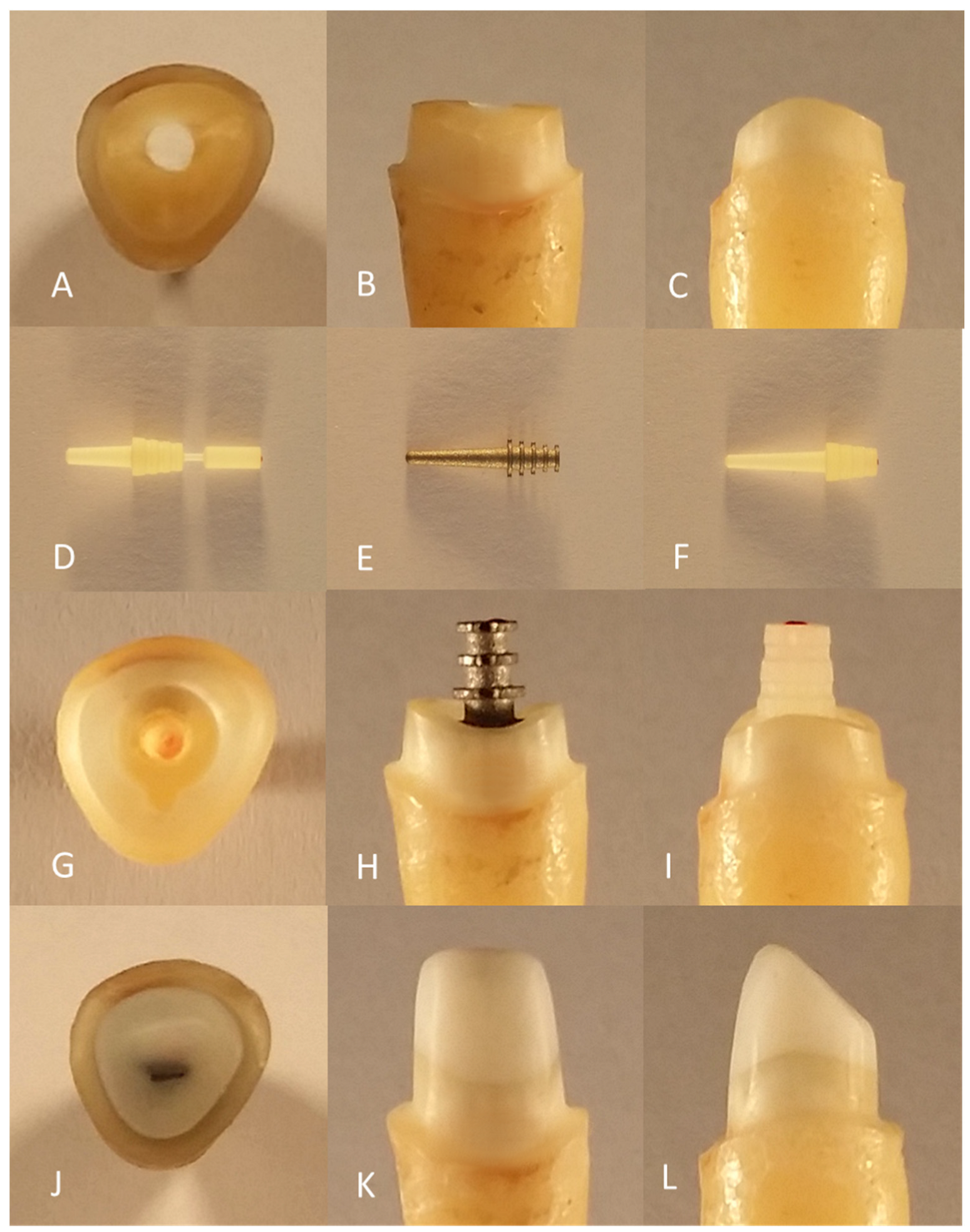

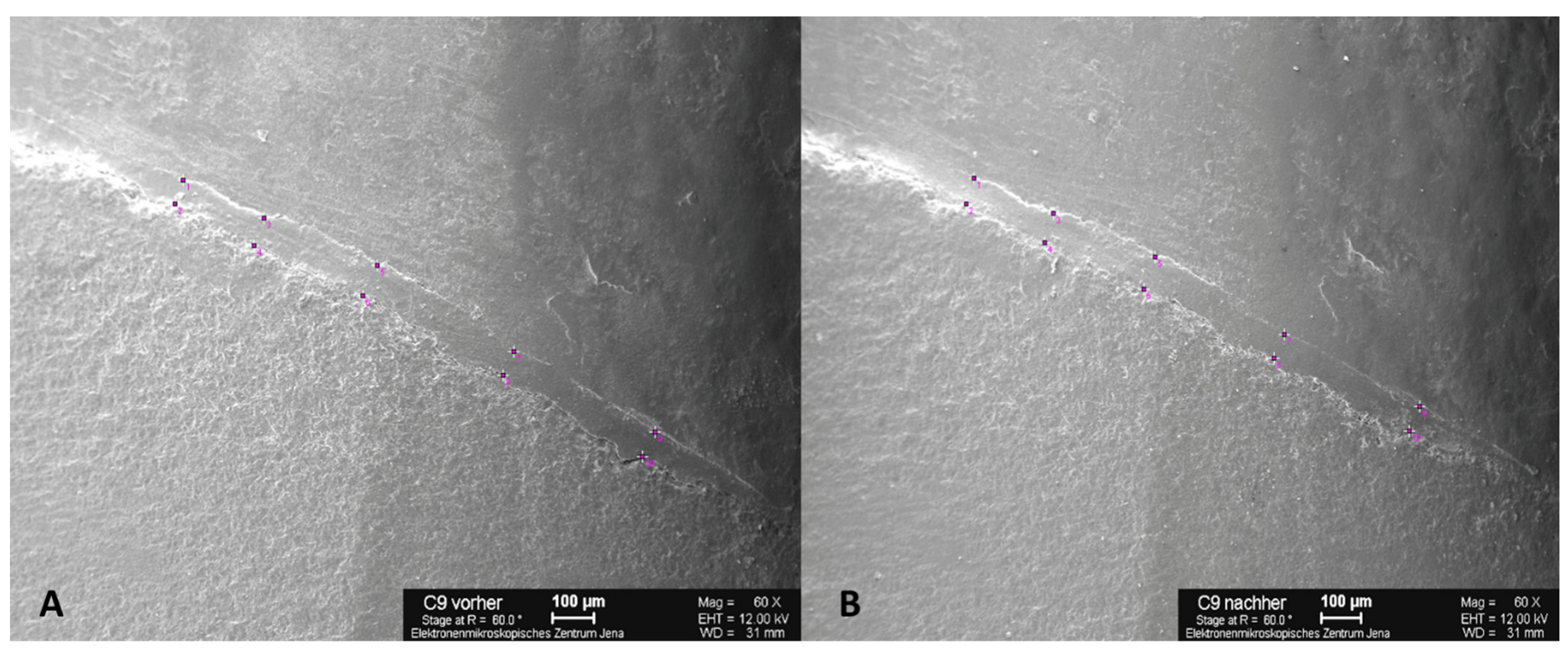

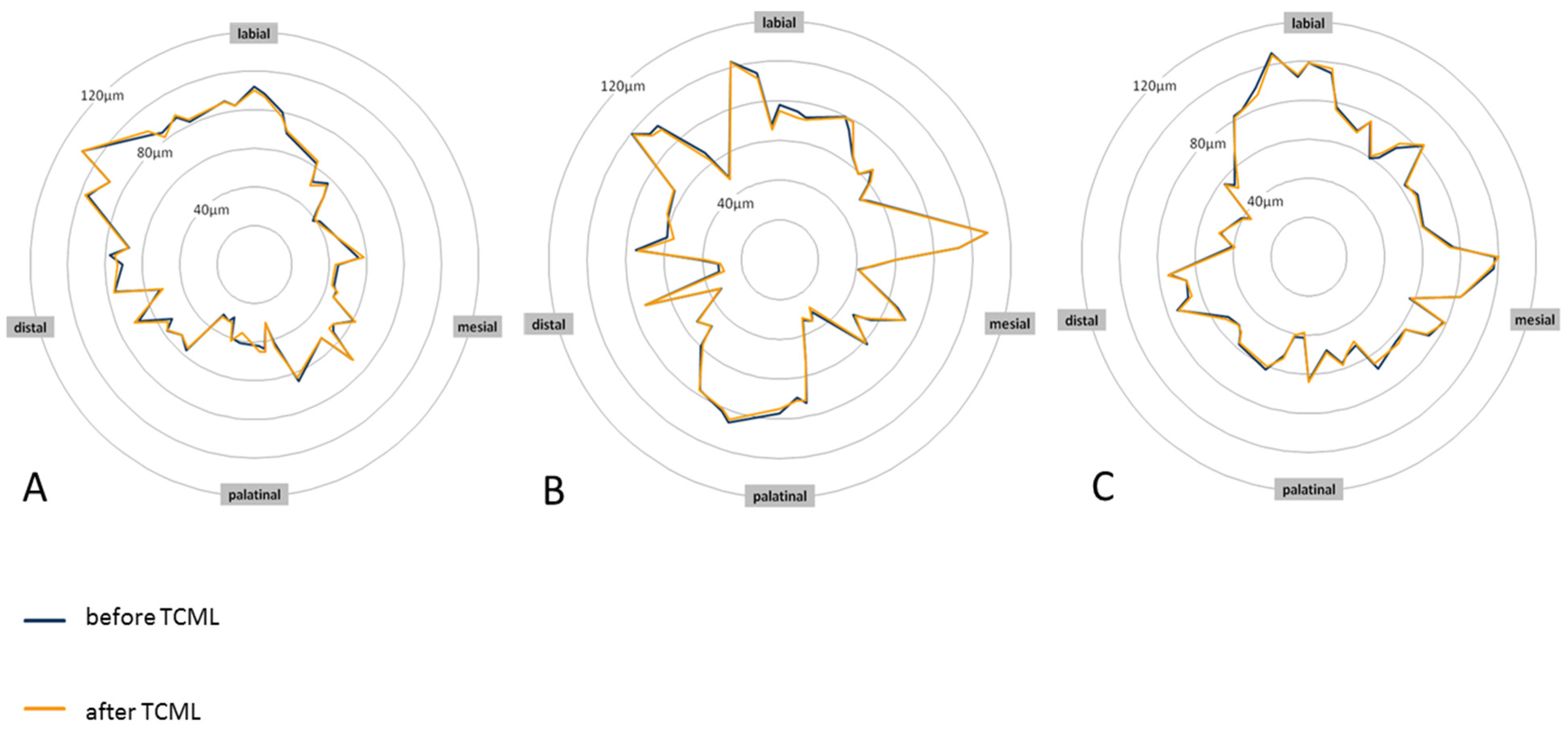
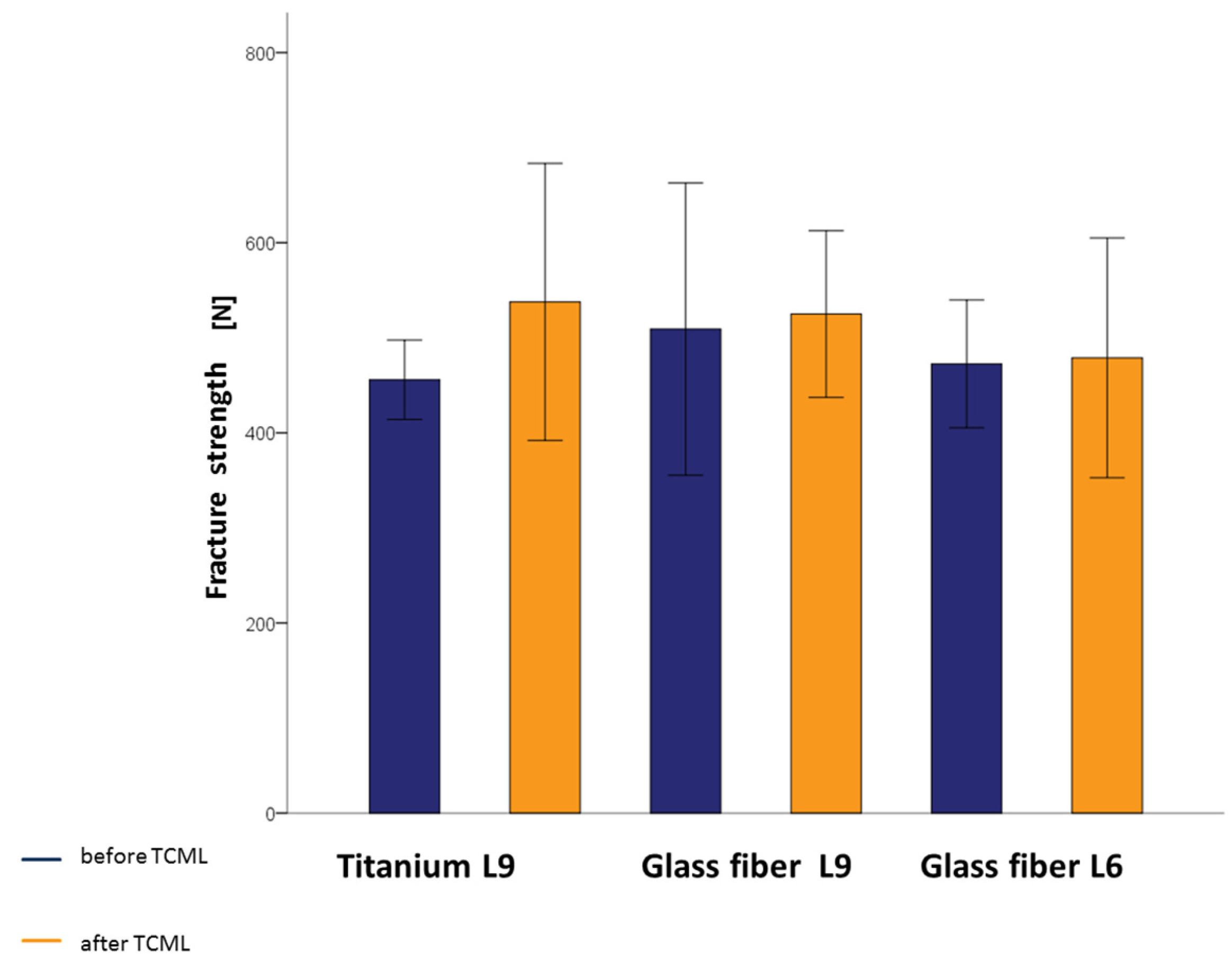
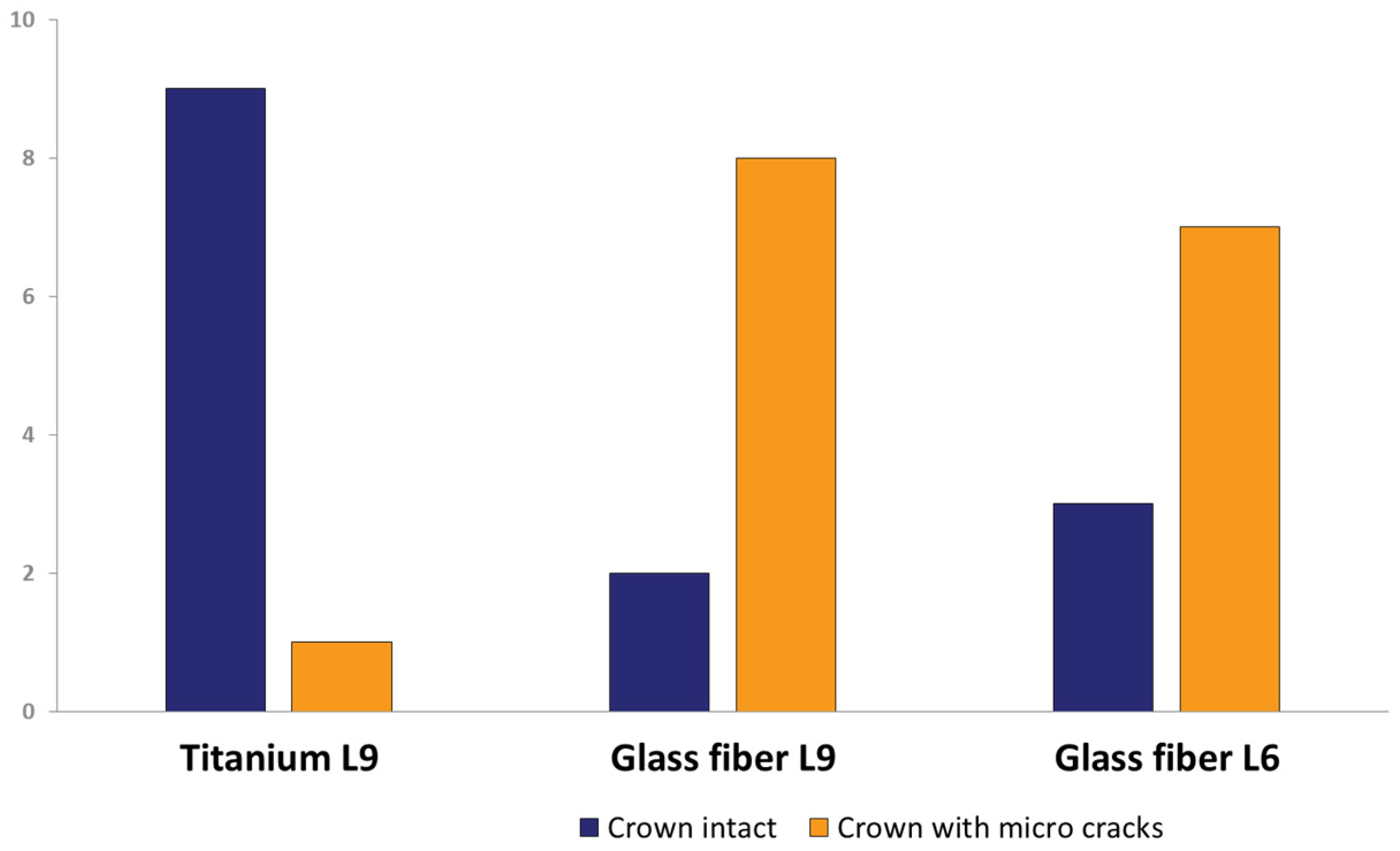
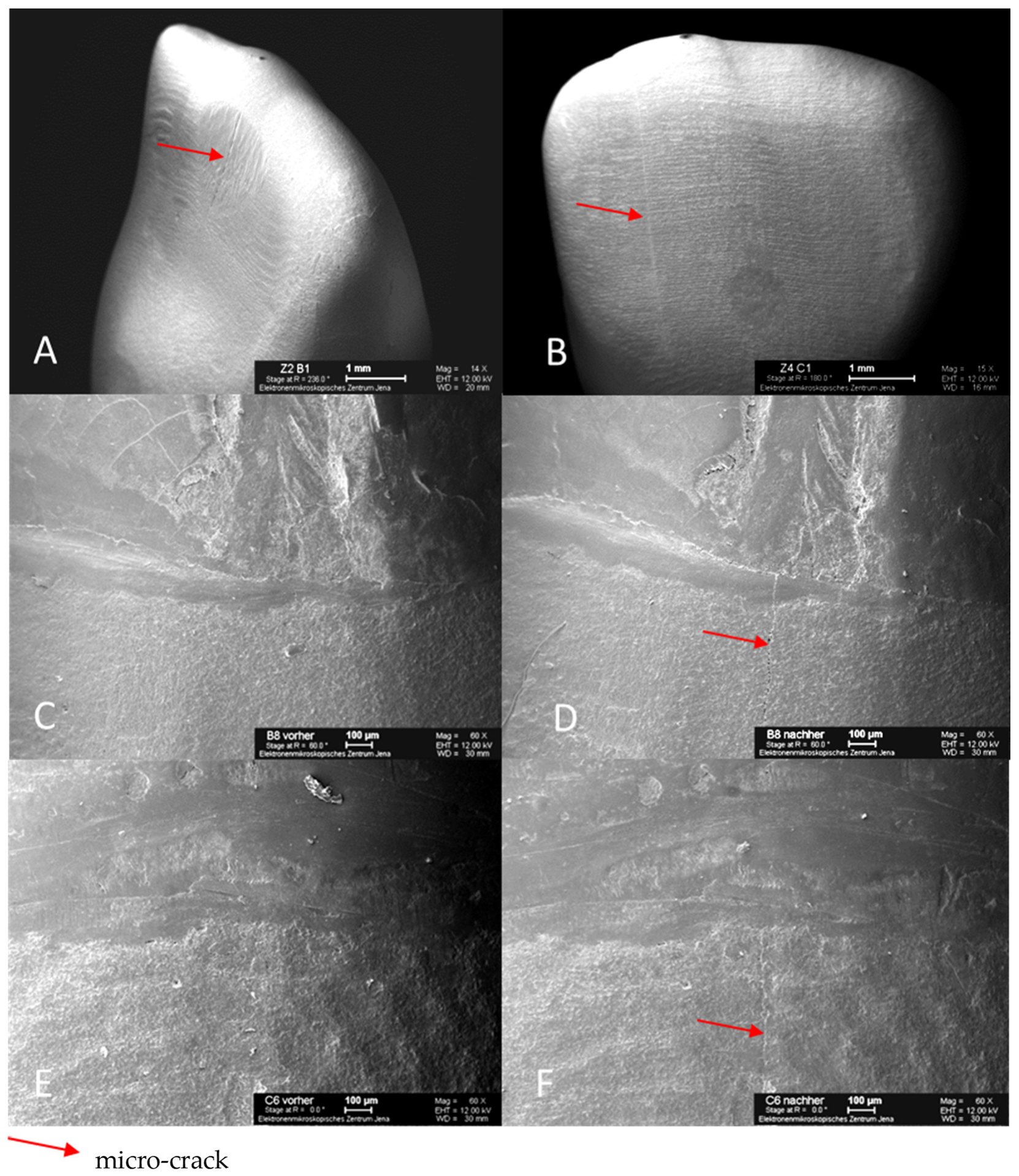
| Titanium L9 | Glass-Fiber L9 | Glass-Fiber L6 | ||
|---|---|---|---|---|
| Designation | ER Kopfstift | ER DentinPost X | ER DentinPost X | |
| 49L9.000.090 | 445L9.000.090 | 444L6.000.070 | ||
| Material | Pure titanium | Glass-fiber-reinforced composite | ||
| Composition | ≤0.35% O | ≈60% glass fiber | ||
| ≤0.30% Fe | ≈40% epoxy resin | |||
| ≤0.06% C | ||||
| ≤0.05% N | ||||
| ≤0.013% H | ||||
| ≤0.04% other | ||||
| Form | Head post with conical shank | |||
| Pitch angle | 2.1° | |||
| Head | Length | 4.5 mm | ||
| Ø coronal | 2.0 mm | |||
| Ø cervical | 2.8 mm | |||
| Shaft | Length | 9.0 mm | 6.0 mm | |
| Ø cervical | 1.56 mm | 1.58 mm | ||
| Ø apical | 0.90 mm | 1.14 mm | ||
| Mean | Standard Deviation | Significance p ≤ 0.05 | Significance between the Groups before TCML | Significance between the Groups after TCML | |||
|---|---|---|---|---|---|---|---|
| Titanium L9 | before TCML | N [10] | 66.10 | 6.38 | 0.996 | ||
| after TCML | N [10] | 66.10 | 6.27 | ||||
| Glass-fiber L9 | before TCML | N [10] | 65.71 | 5.39 | 0.815 | 0.921 | 0.883 |
| after TCML | N [10] | 65.68 | 5.48 | ||||
| Glass-fiber L6 | before TCML | N [10] | 66.66 | 3.61 | 0.141 | ||
| after TCML | N [10] | 66.83 | 3.50 | ||||
| Mean | Standard Deviation | Significance p ≤ 0.05 | Significance between the Groups before TCML | Significance between the Groups after TCML | |||
|---|---|---|---|---|---|---|---|
| Titanium L9 | before TCML | N [6] | 455.8 | 41.7 | 0.123 | ||
| after TCML | N [10] | 537.7 | 145.7 | ||||
| Glass-fiber L9 | before TCML | N [8] | 509.2 | 153.8 | 0.801 | 0.596 | 0.608 |
| after TCML | N [10] | 525.0 | 87.8 | ||||
| Glass-fiber L6 | before TCML | N [10] | 472.6 | 67.3 | 0.894 | ||
| after TCML | N [7] | 478.9 | 126.1 | ||||
Disclaimer/Publisher’s Note: The statements, opinions and data contained in all publications are solely those of the individual author(s) and contributor(s) and not of MDPI and/or the editor(s). MDPI and/or the editor(s) disclaim responsibility for any injury to people or property resulting from any ideas, methods, instructions or products referred to in the content. |
© 2023 by the authors. Licensee MDPI, Basel, Switzerland. This article is an open access article distributed under the terms and conditions of the Creative Commons Attribution (CC BY) license (https://creativecommons.org/licenses/by/4.0/).
Share and Cite
Hennig, C.-L.; Stöcker, A.; Nitzsche, A.; Marquetand, J.; Jacobs, C.; Jahn, F. Influence of Root Post Materials and Aging on Fracture Strength and Marginal Gap Quality of Ceramic Crowns—An In Vitro Study. Materials 2023, 16, 3985. https://doi.org/10.3390/ma16113985
Hennig C-L, Stöcker A, Nitzsche A, Marquetand J, Jacobs C, Jahn F. Influence of Root Post Materials and Aging on Fracture Strength and Marginal Gap Quality of Ceramic Crowns—An In Vitro Study. Materials. 2023; 16(11):3985. https://doi.org/10.3390/ma16113985
Chicago/Turabian StyleHennig, Christoph-Ludwig, André Stöcker, Ann Nitzsche, Justus Marquetand, Collin Jacobs, and Florentine Jahn. 2023. "Influence of Root Post Materials and Aging on Fracture Strength and Marginal Gap Quality of Ceramic Crowns—An In Vitro Study" Materials 16, no. 11: 3985. https://doi.org/10.3390/ma16113985
APA StyleHennig, C.-L., Stöcker, A., Nitzsche, A., Marquetand, J., Jacobs, C., & Jahn, F. (2023). Influence of Root Post Materials and Aging on Fracture Strength and Marginal Gap Quality of Ceramic Crowns—An In Vitro Study. Materials, 16(11), 3985. https://doi.org/10.3390/ma16113985








